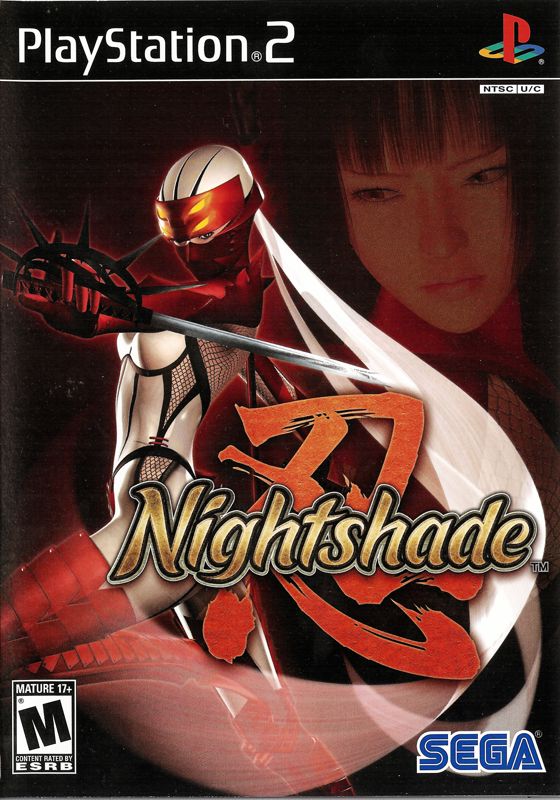Retro Replay Review
Gameplay
Nightshade builds on the fast‐paced ninja action of its predecessor, Shinobi, by deepening its core mechanics and rewarding precision play. You control Hibana, a kunoichi of the Oboro clan, as she infiltrates enemy strongholds, dispatching foes with swift sword strikes, well-placed shuriken, and powerful magic scrolls. From the very first level, the game emphasizes speed and stealth: rushing in blindly will quickly get you overwhelmed, while careful planning and timing turn you into an unstoppable shadow.
One of Nightshade’s most significant gameplay enhancements is the expanded Tate system—long, stylish combat strings that chain together wall-runs, airborne slashes, and finishing blows. The addition of flying kicks to break guards, as well as one-hit stealth kills from above or behind, means combos can now stretch across entire rooms if you keep your momentum and positioning spot-on. The thrill of watching your Tate meter climb higher with each seamless transition never gets old.
Stealth remains paramount. Enemy sightlines, patrol patterns, and environmental hiding spots all factor into your approach. Hibana’s shadow dash allows for rapid repositioning, but it drains quickly if overused, forcing you to balance aggression with patience. Certain levels even introduce light and sound mechanics—duck into tall grass to stay invisible or tread lightly to avoid alerting guards to your presence.
Boss encounters test every tool in your arsenal. From heavily armored samurai to agile ninja rivals, each major fight demands you master scroll spells, counterattacks, and the timing of your Tate combos. While you can brute-force some battles, Nightshade truly shines when you dissect an opponent’s pattern, exploit weaknesses, and weave together the perfect sequence of strikes and stealth kills.
Graphics
Although running on PS2 hardware, Nightshade delivers a striking visual presentation that blends traditional Japanese aesthetics with stylized effects. Character models are sharply defined, with fluid animations that bring each slash and flip to life. Environments range from moonlit bamboo forests to torchlit castle interiors, each rendered with a moody color palette that enhances the game’s ninja theme.
Lighting plays a particularly strong role here. Shadows dynamically shift as lantern flames flicker or distant fires burn, giving stealth sections real dramatic weight—you can practically see the safety of darkness slipping away. Particle effects also stand out: magic scrolls erupt in swirling glyphs, and blood spatter and spark trails punctuate high-speed impacts in vivid detail.
Level design extends beyond visual flair into functional artistry. Rooftops, ledges, and wall surfaces are arranged to facilitate wall-runs and Tate combos, while hidden alcoves and roof overhangs feel purpose-built for ambush tactics. This thoughtful integration of art and gameplay means every set piece not only looks great, but also serves as a playground for your ninja acrobatics.
Cutscenes and character portraits are rendered with hand-drawn 2D art, evoking classic manga panels. Though these moments are brief, they inject personality into Hibana and her adversaries, reinforcing the story’s stakes between missions. Overall, Nightshade’s graphics manage to feel both polished and purposefully stylized, delivering an experience that still holds up years after its release.
Story
Nightshade opens with the Oboro clan in disarray. The Nakatomi company has begun gathering the shattered pieces of the Akujiki sword—a legendary blade once broken by Hotsuma in Shinobi. With the clan’s honor and the fate of feudal Japan at risk, Hibana steps forward to retrieve the fragments before they fall into the wrong hands. It’s a classic tale of duty, vengeance, and the pursuit of power, told through succinct dialogue and dynamic in-game cutscenes.
As you progress through winding mountain passes, serene temple complexes, and clandestine underground lairs, the narrative unfolds in measured doses. Supporting characters from the Oboro clan lend snippets of backstory, while cryptic messages from Nakatomi’s leadership hint at darker ambitions. Though not overly elaborate, the plot provides enough motivation to keep you invested in each mission’s objectives.
Encounters with rival ninjas and powerful warlords serve double duty: they test your skills and reveal bits of lore about the Akujiki sword’s origins. Every boss fight feels thematically tied to the story—whether you’re dueling a samurai sworn to protect a shard or disrupting a dark ritual meant to imbue the blade with new powers. These moments pack more narrative punch than your average action game.
While some players might crave deeper character arcs or branching storylines, Nightshade’s straightforward approach works in its favor. It never bogs you down with cutscene overload or needless exposition. Instead, it trusts you to piece together the larger conspiracy through environmental cues and sparse, impactful dialogue.
Overall Experience
Nightshade is a masterclass in focused, high-octane ninja action. Its blend of stealth, acrobatics, and combo-driven combat keeps you on your toes without ever feeling unfair. The difficulty curve is well-balanced—early levels teach you the ropes, while later stages demand precision timing, perfect spatial awareness, and creative use of your full move set.
The game’s pacing strikes a satisfying rhythm: intense combat chapters are followed by quieter stealth segments, allowing you to catch your breath and plan your next move. Side objectives—such as collecting hidden scrolls, rescuing captive allies, or completing time trials—extend replay value and encourage mastery of each level’s layout and enemy patterns.
Audio design deserves special mention. A pulsating soundtrack combines traditional Japanese instruments with driving percussion, perfectly underscoring moments of stealth and all-out assault alike. Sound effects are equally crisp—the whisper of a kunoichi’s footsteps, the clang of steel on steel, and the explosive crackle of magic scrolls all contribute to an immersive atmosphere.
Between its strong core mechanics, stylish presentation, and concise yet engaging story, Nightshade remains a standout title in the PS2 library. Whether you’re a series veteran or new to the Oboro clan’s exploits, this kunoichi’s quest to reforge the Akujiki will keep you hooked from the first stealth kill to the final climactic showdown.
 Retro Replay Retro Replay gaming reviews, news, emulation, geek stuff and more!
Retro Replay Retro Replay gaming reviews, news, emulation, geek stuff and more!




Reviews
There are no reviews yet.